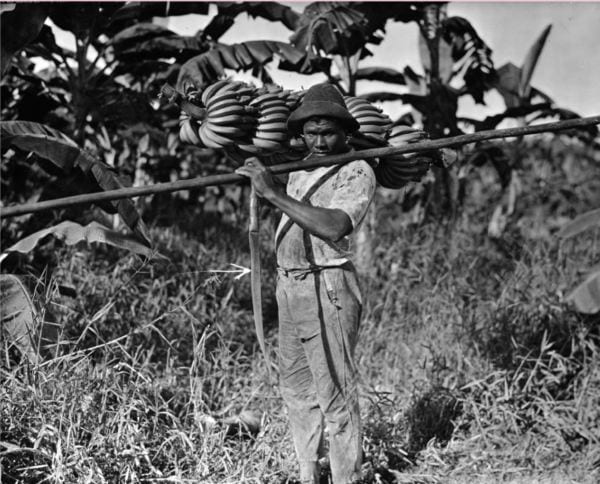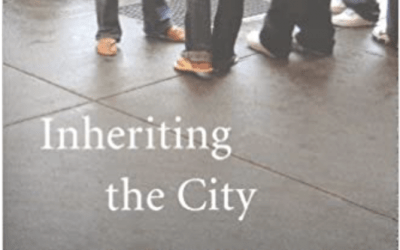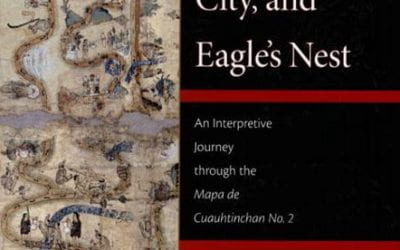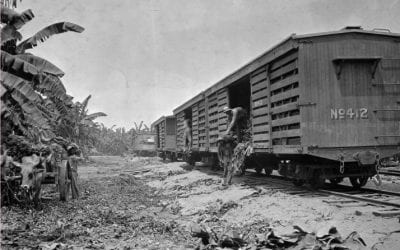Making A Difference: The United Fruit Company Collection at the Harvard Business School

Handling bananas, backing the bunch, Colombia, 1924. Photo courtesy of Baker Library Historical Collections, Harvard Business School
Baker Library Historical Collections at Harvard Business School has extensive photographic collections documenting a range of companies and activities. Perhaps the most significant collection is the United Fruit Company Photograph Collection. Donated to Harvard Business School in 1979 by the United Brands Company, the United Fruit Collection consists of seventy-five photograph albums that illustrate the company’s extensive operations in Central and South America and the United States. The photographs were taken between 1891 and 1962, with the majority dating from the 1920s through the 1950s. The albums contain approximately 10,400 photographs that vary in size from 3 x 5 inches to 9 x 11 inches. Most of the photographs are accompanied by brief captions that describe their content.
Thousands of photographs depict the operations of the company including agricultural operations, construction, and research activities. The company’s many units produced bananas, sugar, abaca (for use as hemp), cacao, palm oil, cattle and mahogany. Planting, spraying, irrigation, harvesting the crops, the construction and running of railroads, and the building of the wharves are all documented in these photos. Also recorded is evidence of hardships and damage suffered from floods, windstorms and fire. This photograph collection also offers deep insights into the daily life in the company towns and villages, both for the workers and the managers. Images of students in the company schools, doctors, nurses and patients in the company hospitals, shoppers in the company stores and shots of the workers’ baseball teams and the managers’ tennis courts capture a way of life and are valuable documents in understanding the social and cultural history of this region.
The United Fruit Company Photograph Collection is one of the few archival collections on this significant company available to researchers and as a result is the most heavily consulted photographic collection. We welcome research requests for the United Fruit Collection. Please contact the Baker Library Historical Collections reference and research team at histcollref@hbs.edu for further information on the collection and access to these materials.
Winter 2009, Volume XIII, Number 2
Laura Linard is Director of Baker Library Historical Collections at Harvard Business School.
Related Articles
A Review of Inheriting the City: The Children of Immigrants Come of Age
As an immigrant trying to understand urban diversity here, I come back time and again to the U.S. writer E.B. White’s often-cited passage in Here is New York (1948) in search of useful clues. “There are roughly three New Yorks. There is, first, the New York of the man or woman who was born there, who takes the city for granted and accepts its size, its turbulence as natural and inevitable. Second, there is the New York of the …
A Review of Cave, City, and Eagle’s Nest: An Interpretive Journey through the Mapa de Cuauhtinchan No. 2
The publication of Cave, City, and Eagle’s Nest is an exceptional achievement, bringing into the light a tremendously important but formerly obscure Mesoamerican codex or pictographic text. Analogies to the (re)discovery and interpretation of the Dead Sea Scrolls are not unwarranted insofar as the book marks the reemergence of a fabulous and fabulously significant 500-year old document—the Mapa de Cuauhtinchan N…
Making A Difference: Repatriating Photographs
I first learned of the United Fruit Company’s operations in Colombia, like many people, when I read Gabriel García Márquez’s 100 Years of Solitude and its description of the 1928 massacre of banana workers in Santa Marta. A few years later, I was researching United Fruit for my dissertation, and was met with a wall of silence when I tried to contact the company to gain access to its records. Several other scholars including Philippe …




